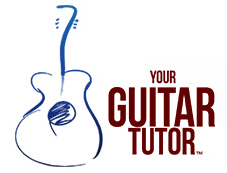Tuning Your Guitar
There are numerous tunings for you to experiment with as you progress, but the essential tuning to begin with is Standard Tuning. Standard tuning will allow you to learn the content covered throughout the eBooks as well as play along with 99% of the songs you hear on a daily basis.
10 Steps To Successfully Tune Your Guitar
- Take your guitar and guitar tuner out and place the tuner on your knee or a surface in front of you.
- Turn the guitar tuner on
- Play the thickest string without pressing down the string onto a fret (play the open string) whilst watching the screen of the tuner, identify the current note the string is playing.
- Reach over to the top of the neck (Headstock) and identify which tuning key is for the lowest string. To find out which tuning key is for which string you need to follow the string up the fretboard until it winds onto the tuning key. Now hold this tuning key before striking the string with your right hand.
- You are aiming to get this string to play an E note, so is it higher or lower than an E? If it says Eb this means you need to tighten the string until the flat symbol (b) disappears and you are left with an E on the screen. Perhaps you are seeing an F on the screen, this means you need to loosen the string until you see an E appear. Aim to tune the string until you can get the dial to show a green light or bleep as some tuners do to show you are in tune. You will notice that you may have to pick the string a few times with a few seconds gap between whilst tuning. You can tell the string is being loosened when you are turning the correct tuning key at the headstock and the pitch is going down.
- The next string should be an A note so you take the same process as you did with the E string but now one string down. If you see a flat symbol (b) next to the A note then you need to tighten the string until the flat symbol disappears. If you see a B or Bb then simply loosen the string until you reach the desired note- A.
- Next string down is the D string and we take the exact same process but now aim for the string to play a D note. You may see a flat symbol next to the D note, in this case tighten the string until it disappears. If you see an E or F then loosen the string until you reach the desired note of D.
- Below the D string we have a G string and as you may expect, we take the same steps as before but now aiming to reach a G note. If you see an F# appear on the screen this means you need to tighten the string until a G appears. If you see a G# (G sharp) appear then you need to loosen the string until a G appears. Do not worry too much at this point what these symbols next to the letters mean as I will explain this in more detail when you need to know.
- Below the G string we have a B string. If you see a flat symbol next to the note then tighten the string. If you are seeing a C note then loosen the string.
- Finally you have your highest string and this needs to be tuned to an E note. You may notice that both the thickest and thinnest strings are tuned to an E note yet one sounds low and one sounds high.
Creating A Way To Remember The Tuning Notes
You need to create a way to remember each string name such as the example below or feel free to use this one if you like it.
Every Ant Does Guitar Before Eating
Musical Alphabet
So you know the notes we use in music, here is the musical alphabet. Remember these three simple rules and you won’t go wrong.
- There are no sharps or flats between B and C and between E and F
- Our musical alphabet is from A to G sharp
- A note that is sharp or flat can be called either. Here is an example of my point, you see the note C# appear on the tuner screen when you are trying to reach the D note for the D string. You could also call the C# note Db as they are the same note. This may sound pointless but you will discover later on why we have this system. For future reference this is known as an Enharmonic Equivalent and you can apply this to any note that is sharp or flat.
Musical Alphabet using sharps
A A# B C C# D D# E F F# G G#
Musical Alphabet using flats
A Bb B C Db D Eb E F Gb G Ab
For any questions on tuning please drop a forum post or use the contact form to privately contact me. Subscribe to blog- guitar lessons today to be notified of free weekly guitar lessons.
Have fun!
Tom@YourGuitarTutor
